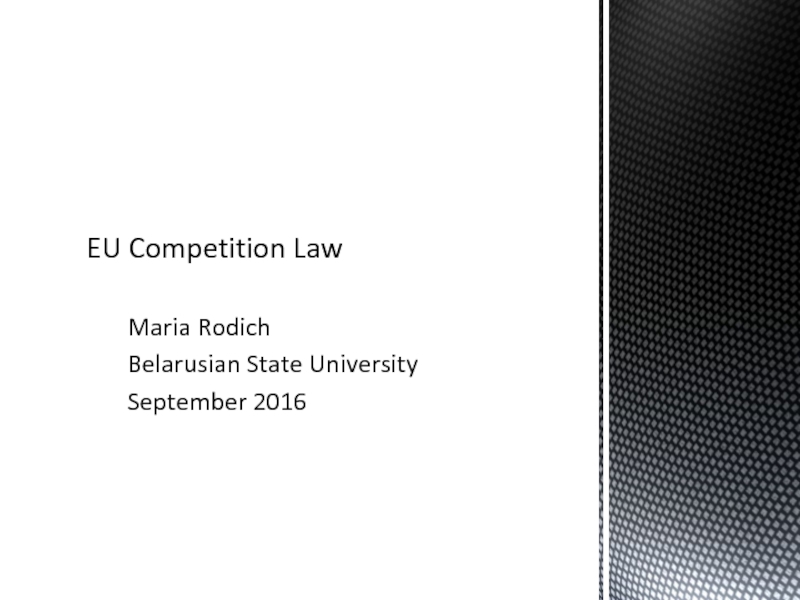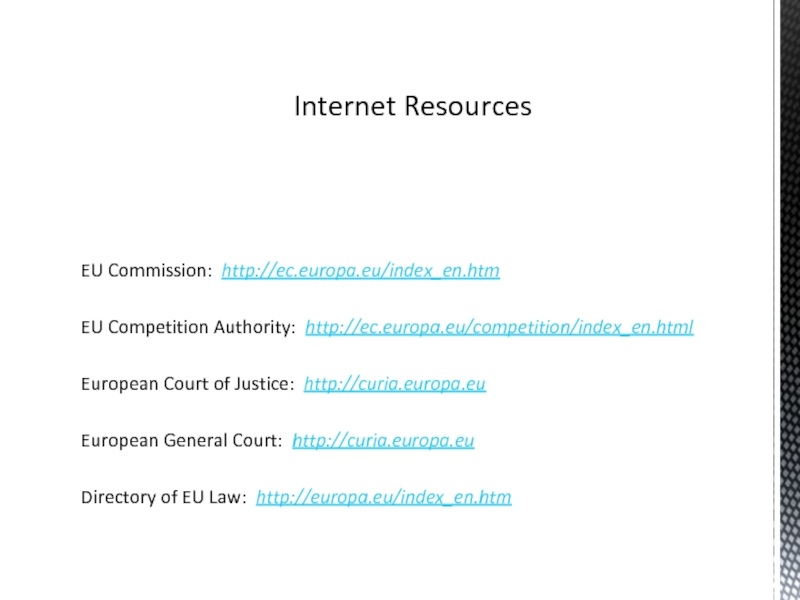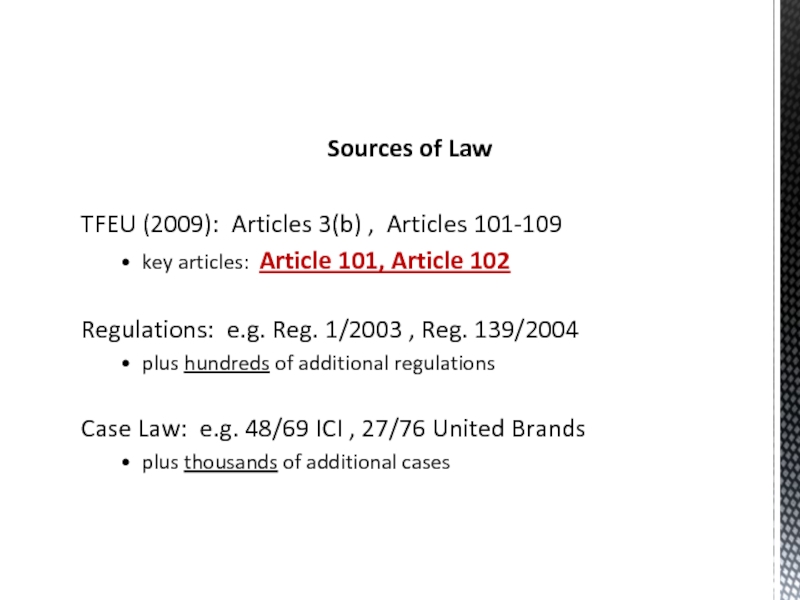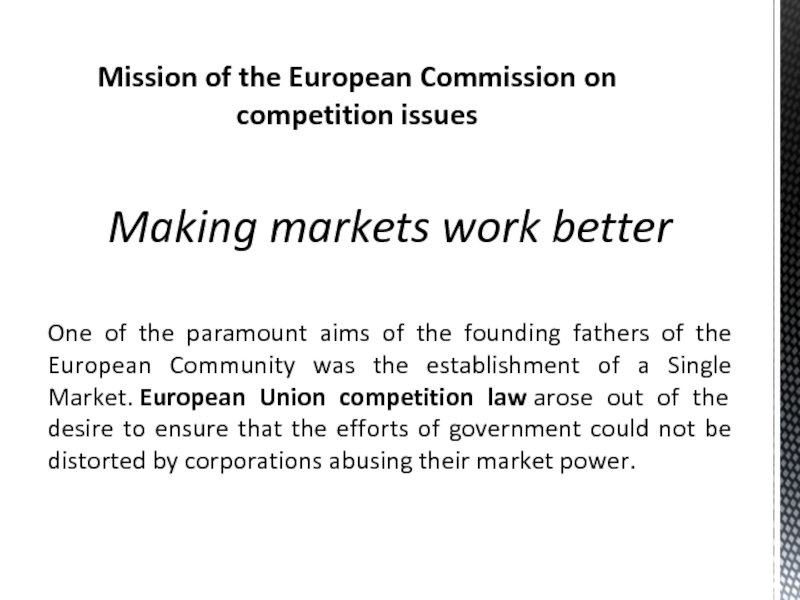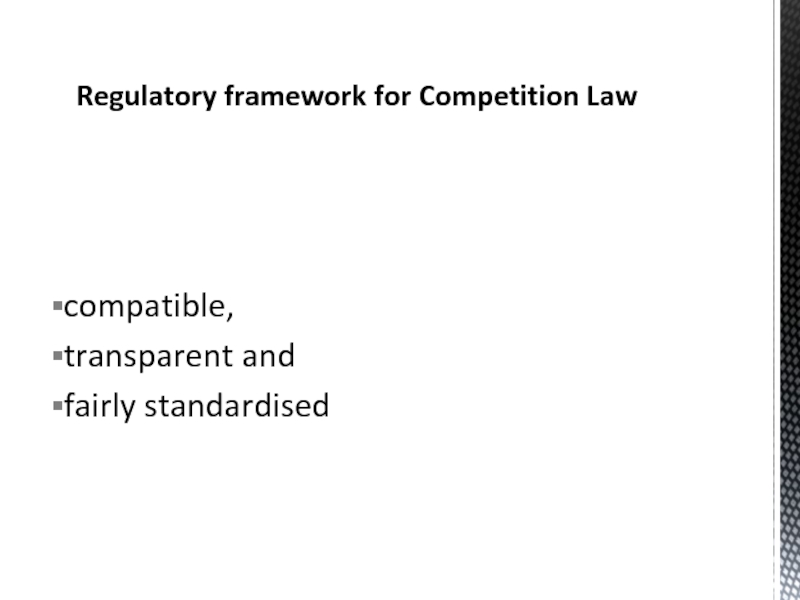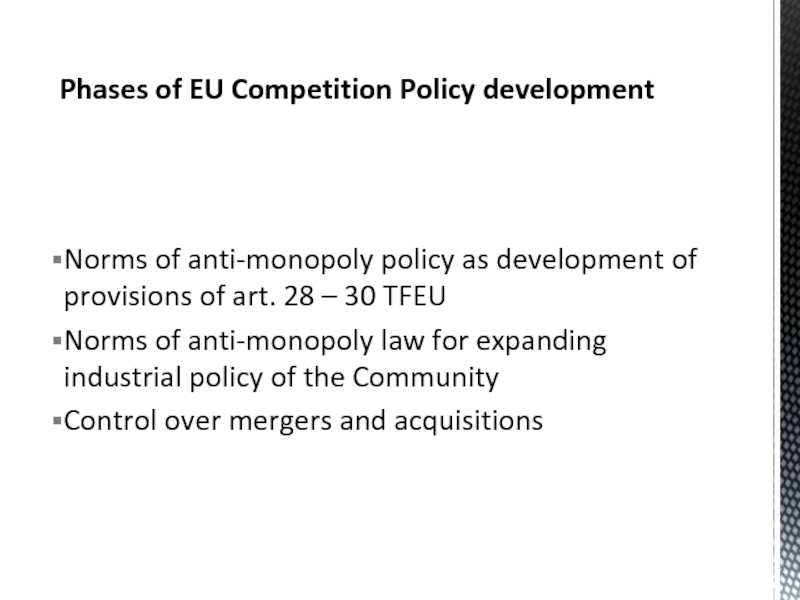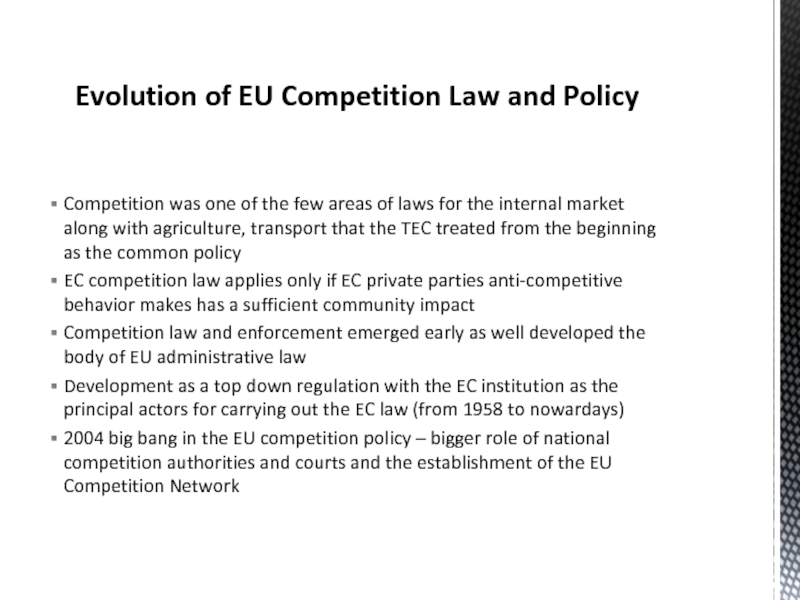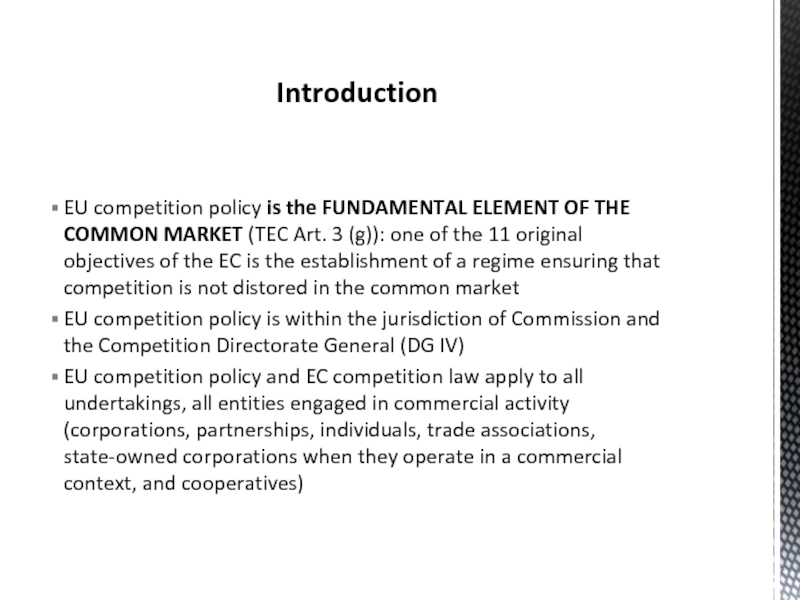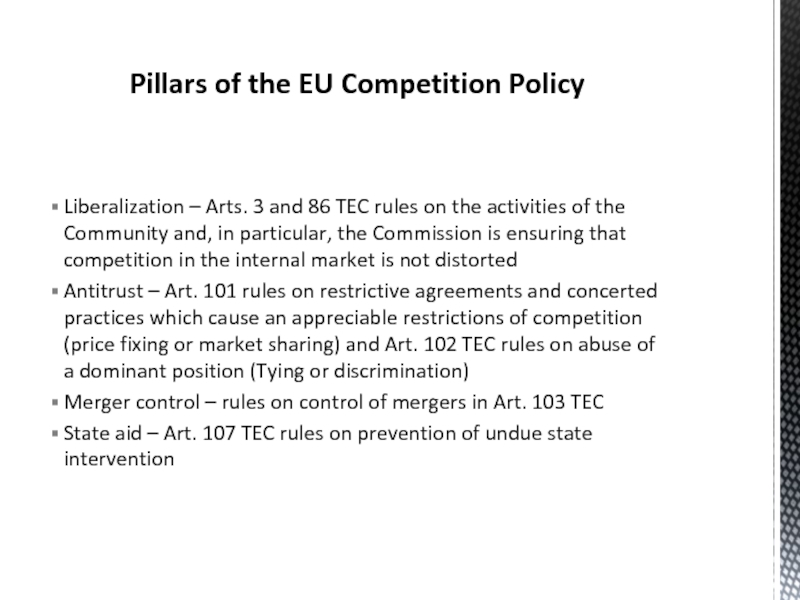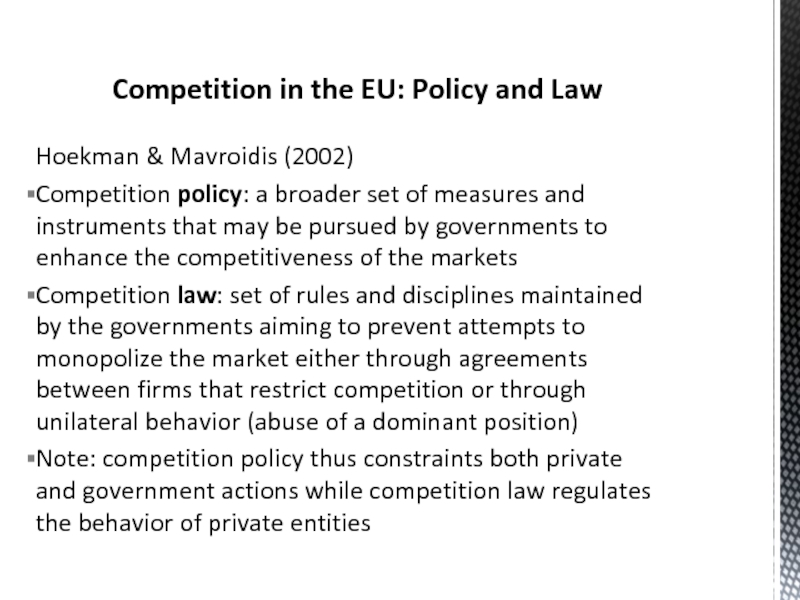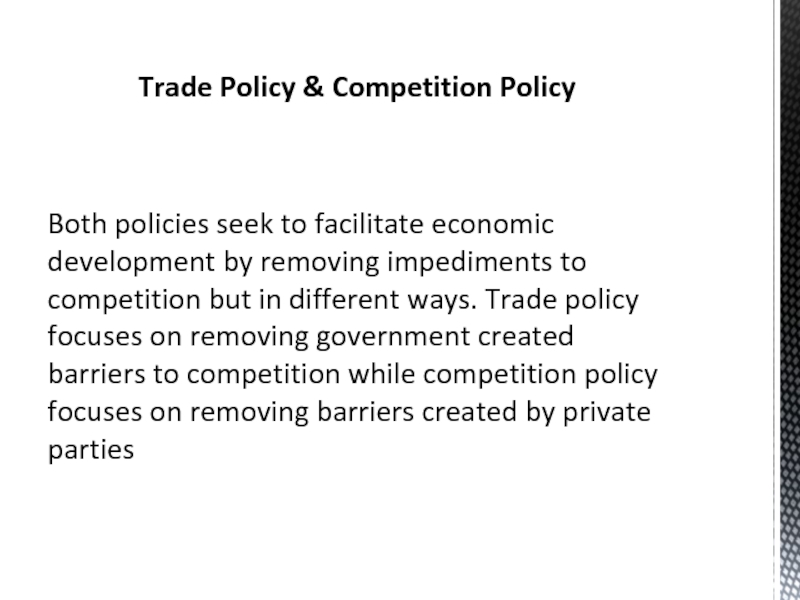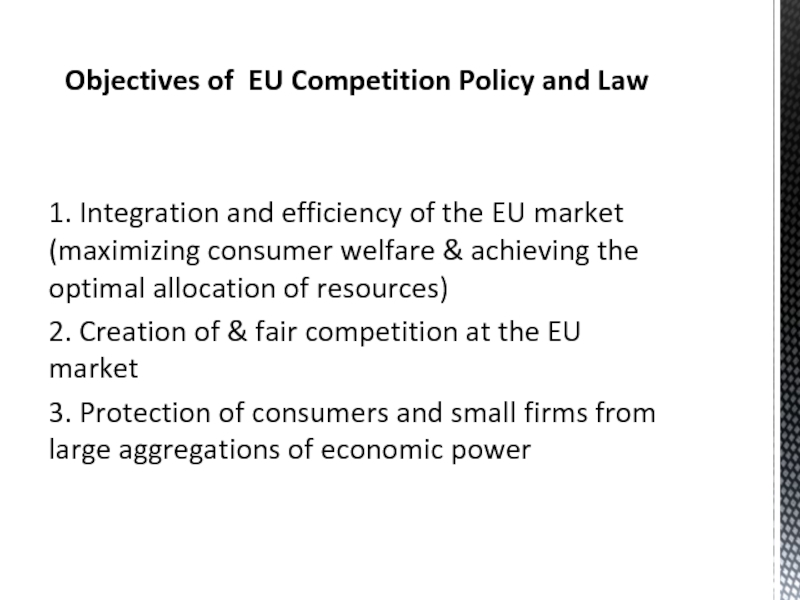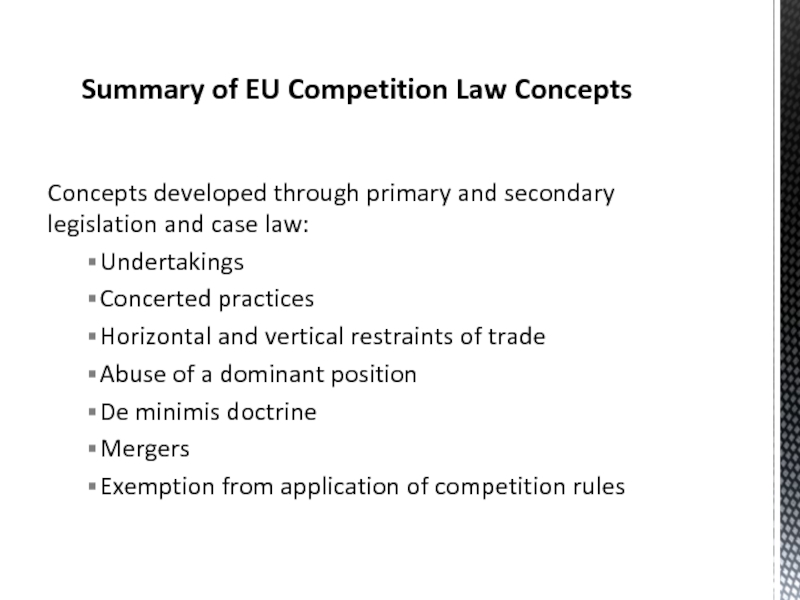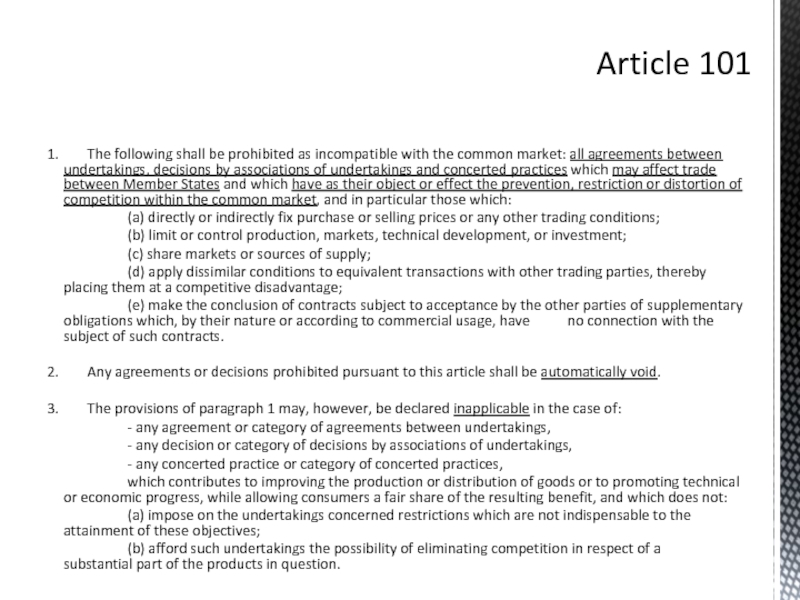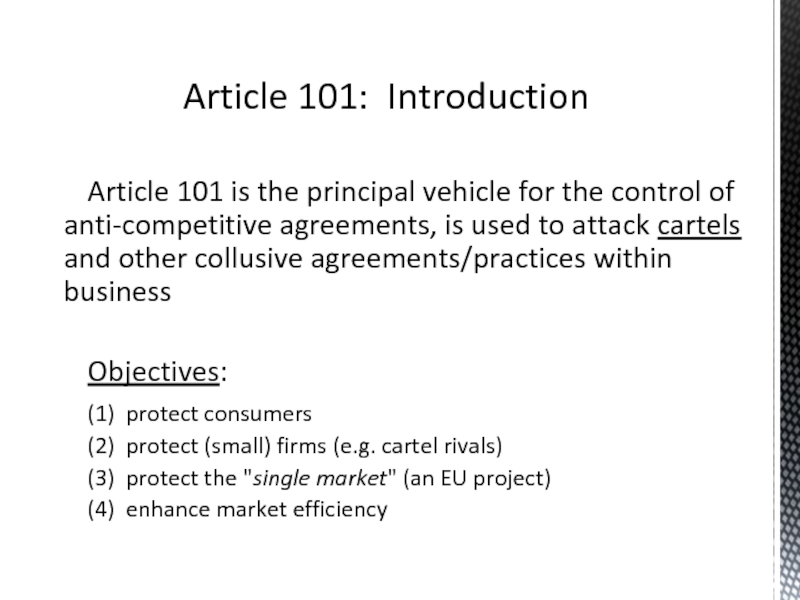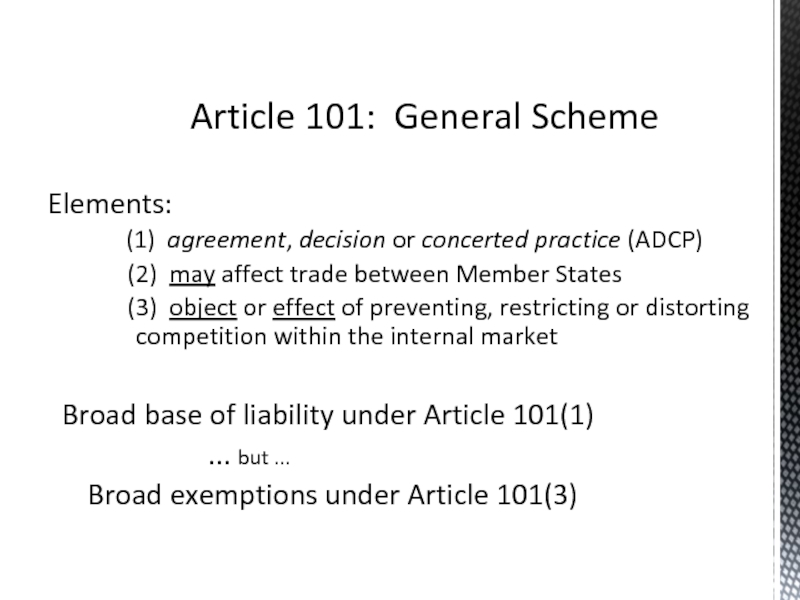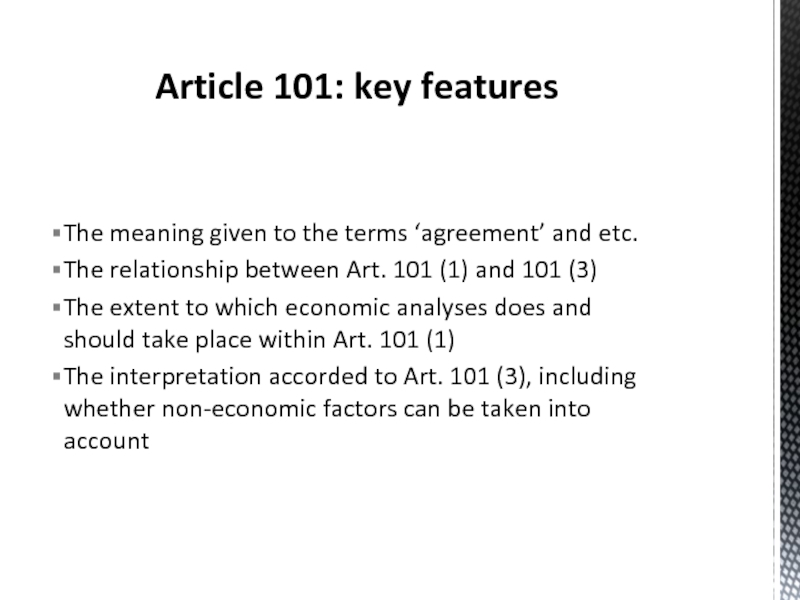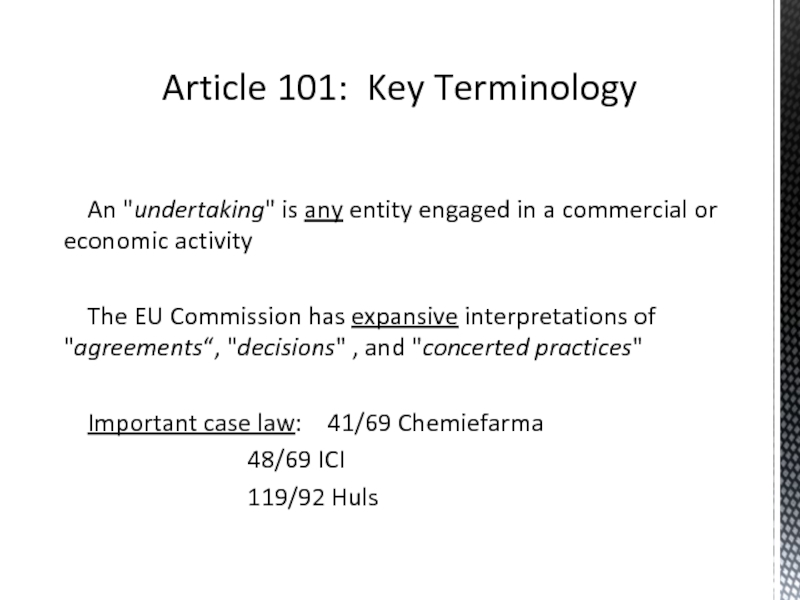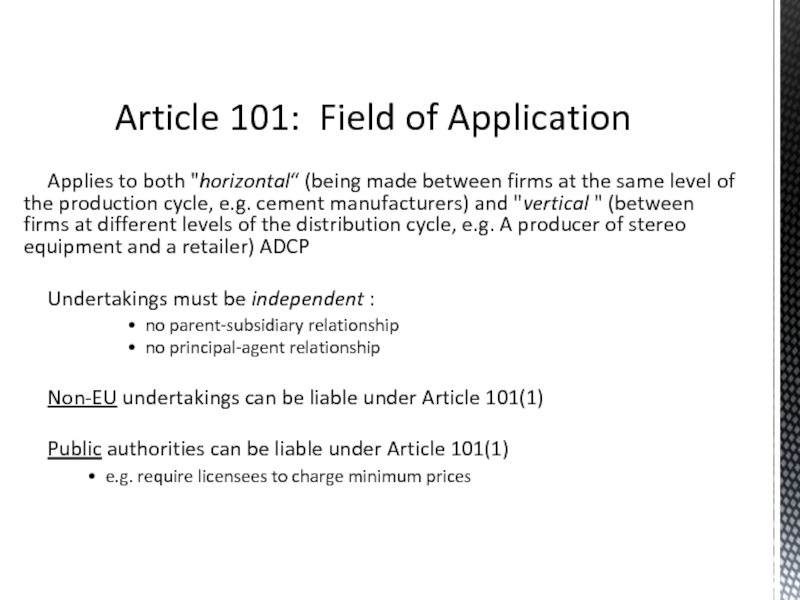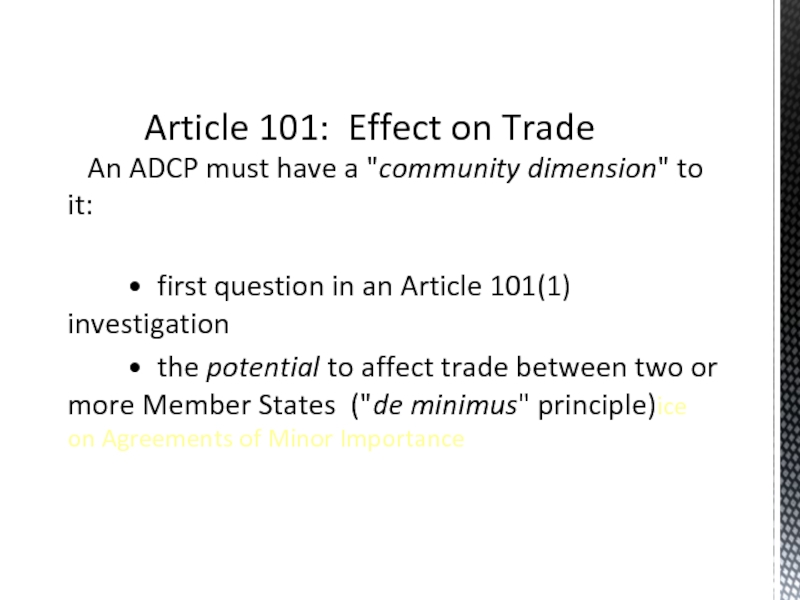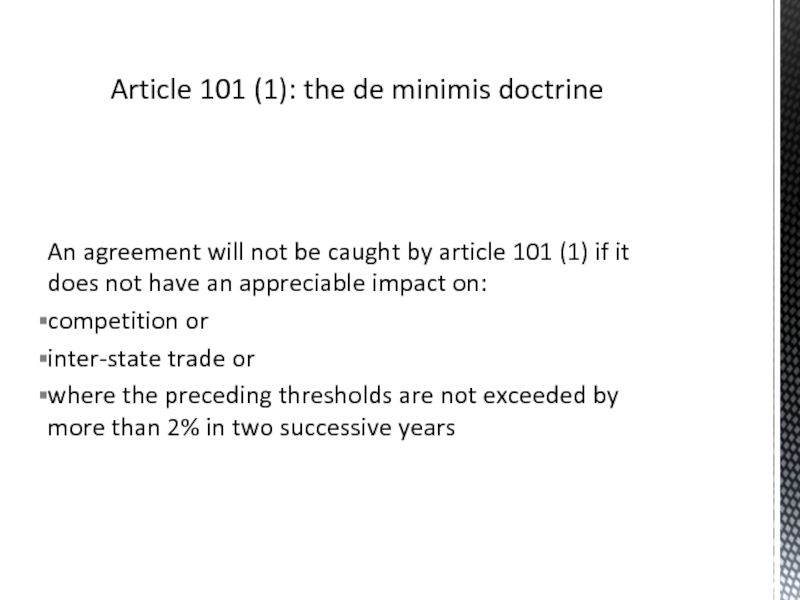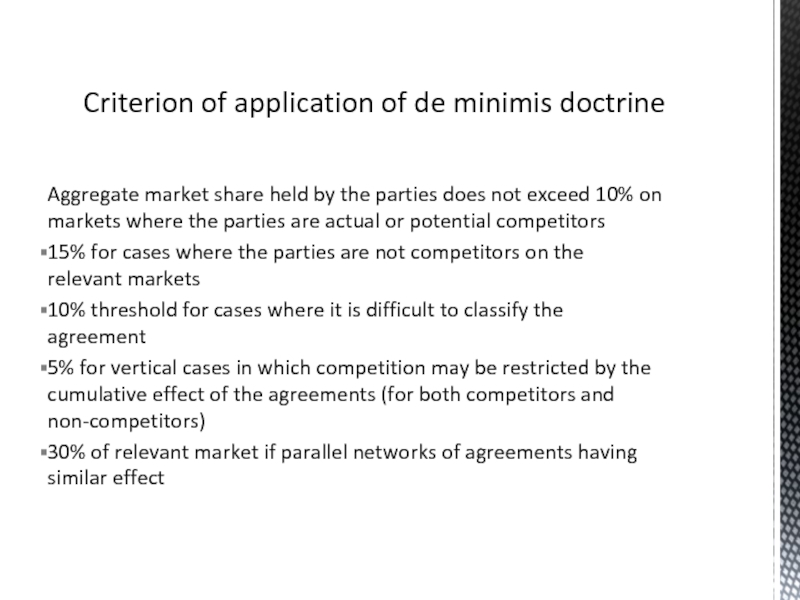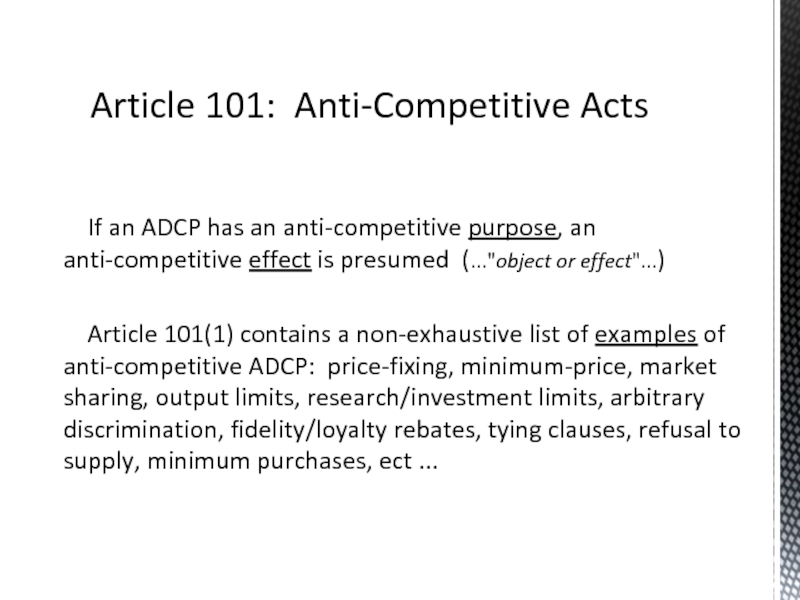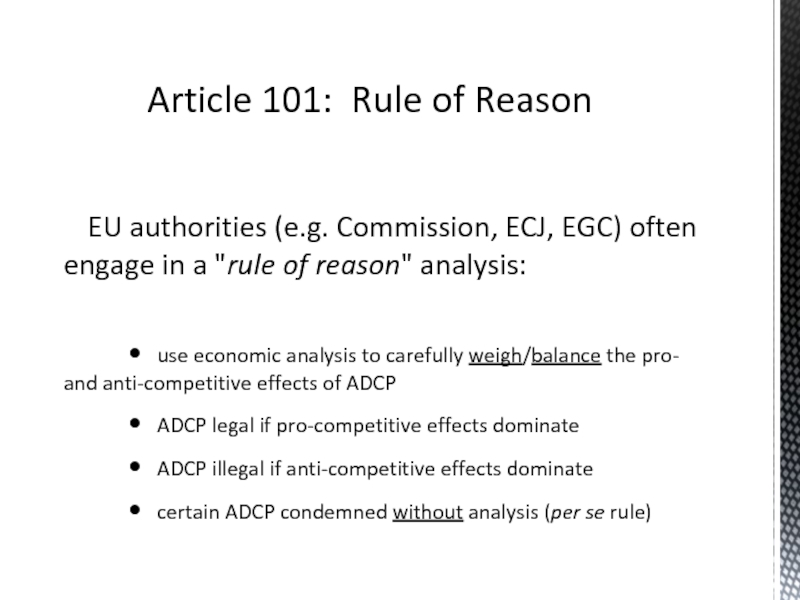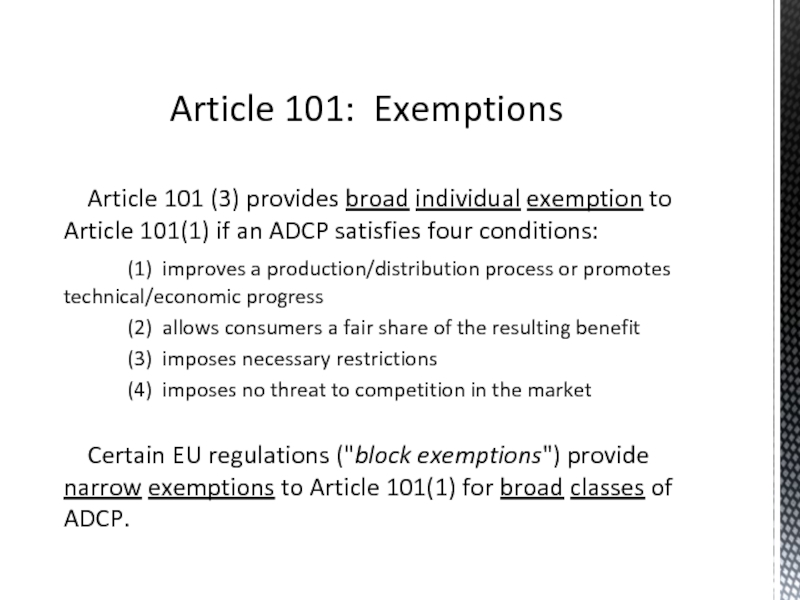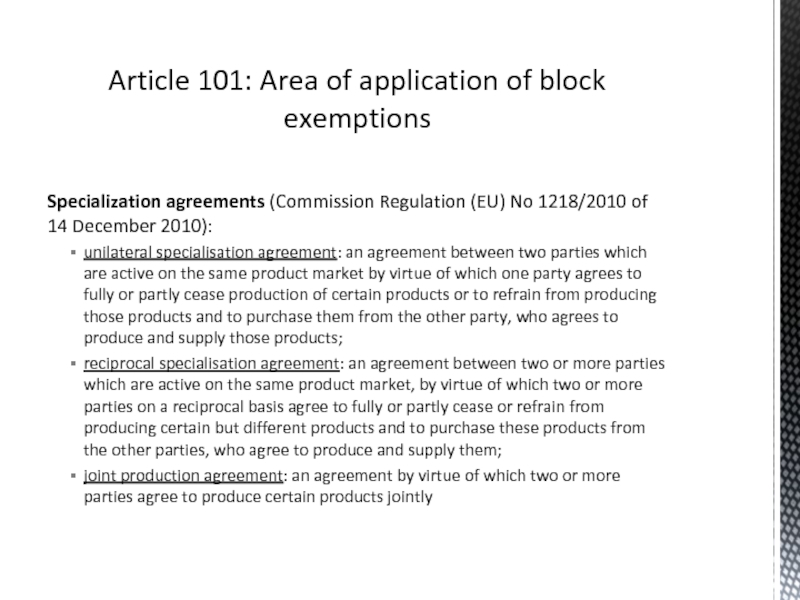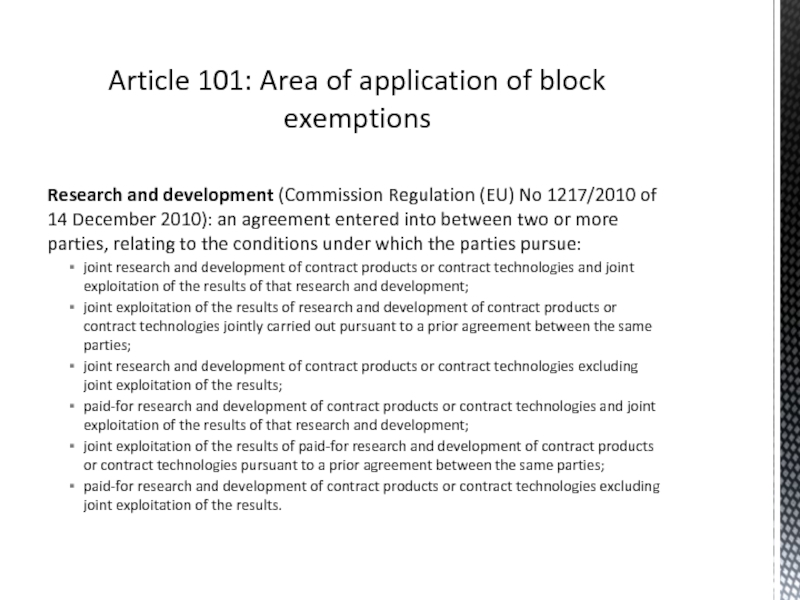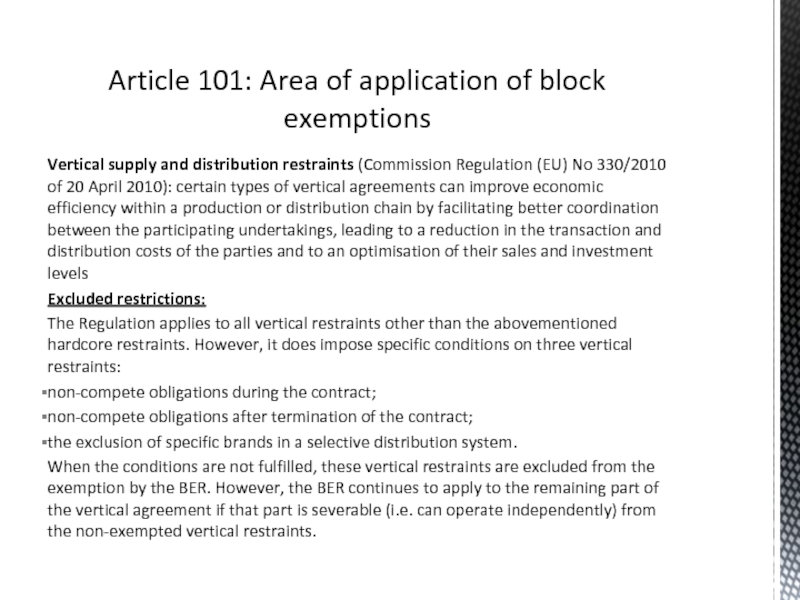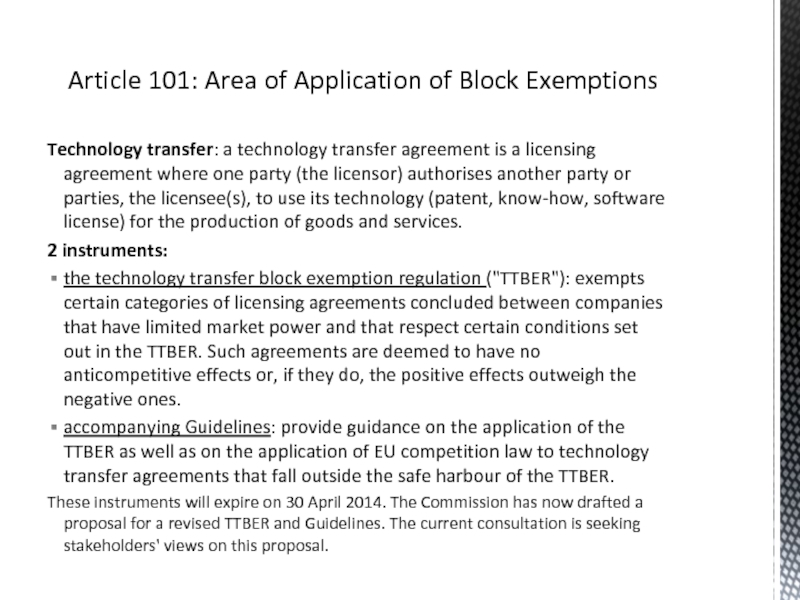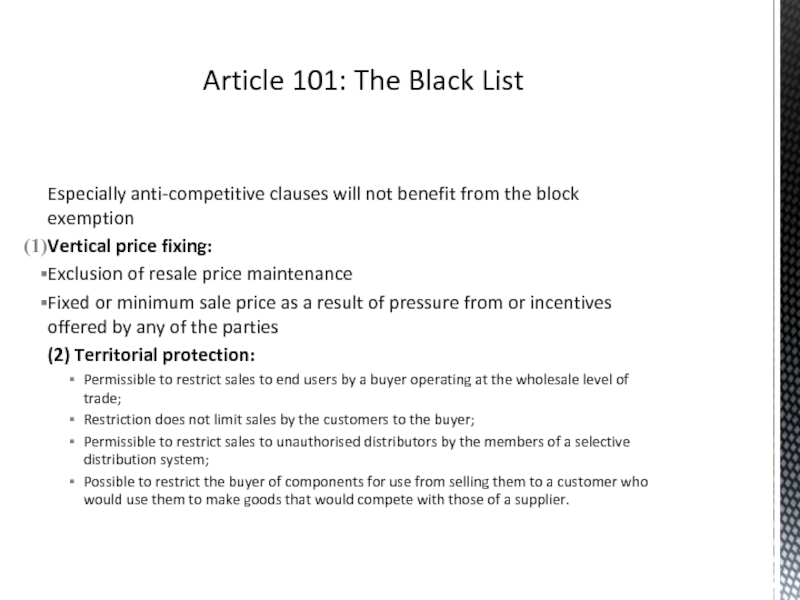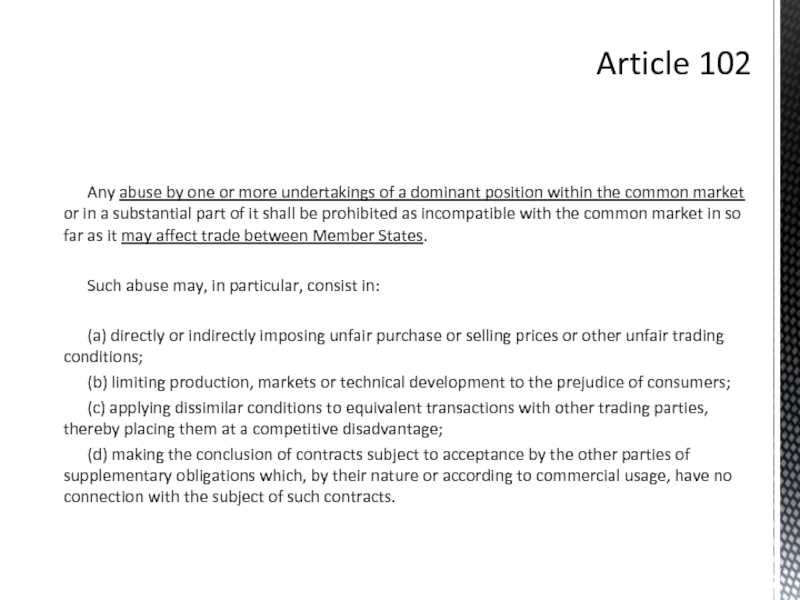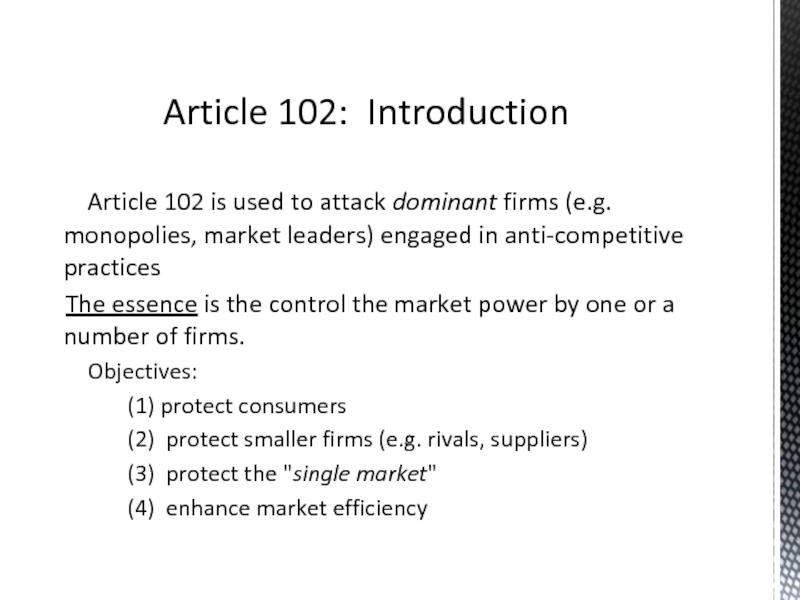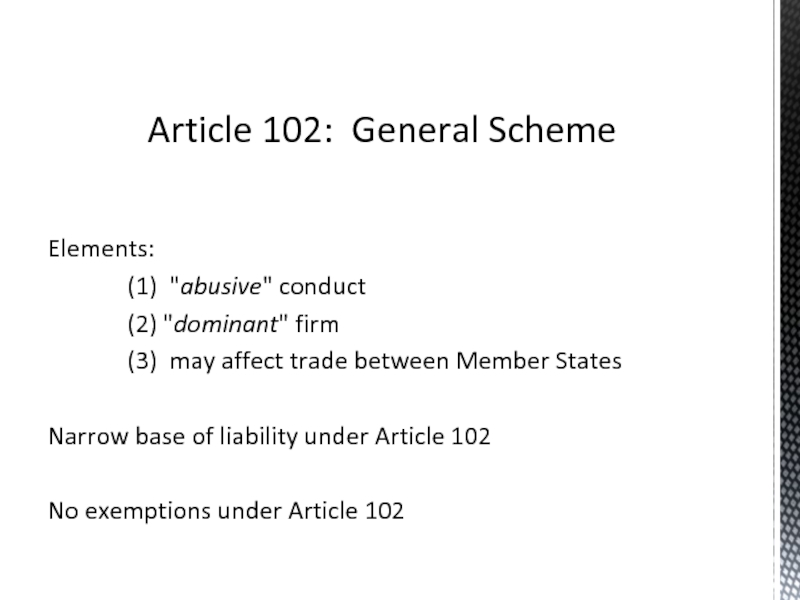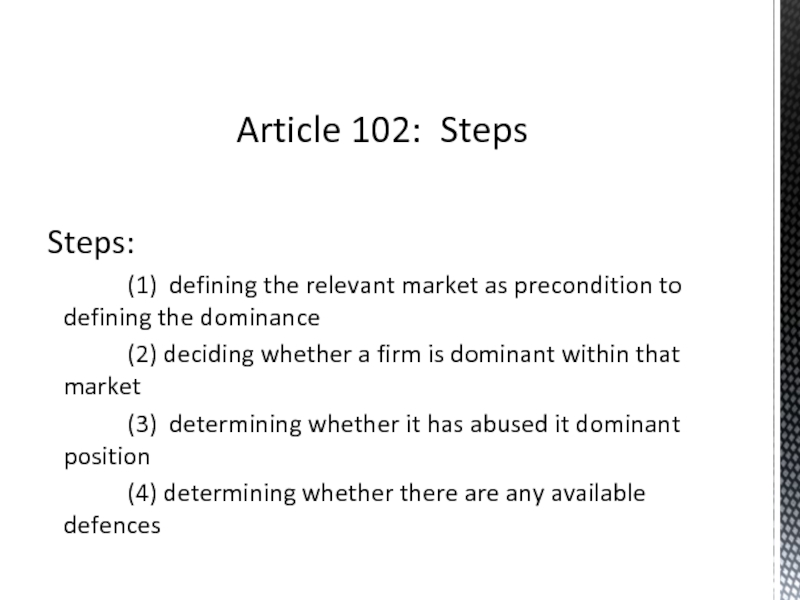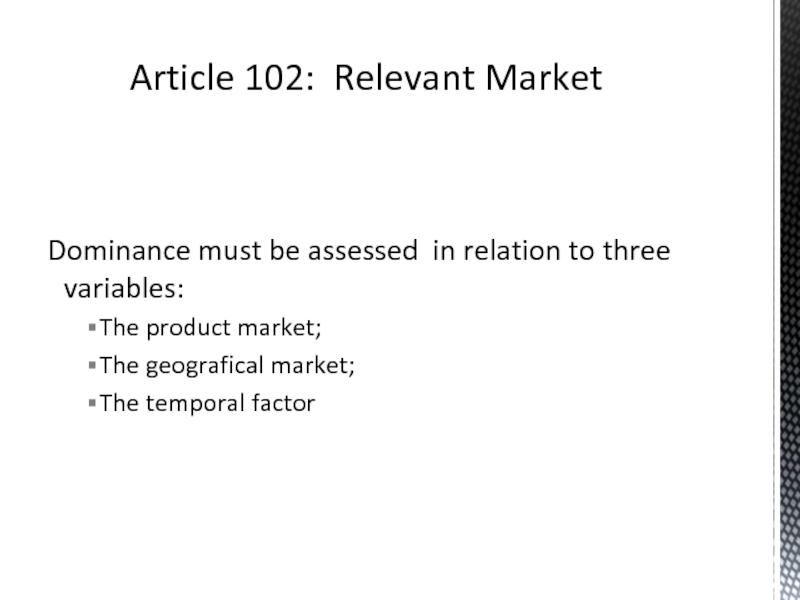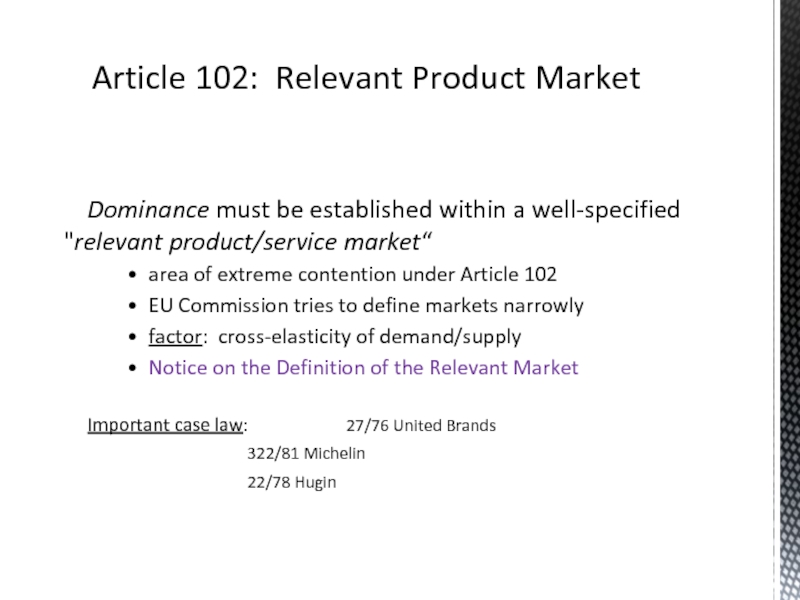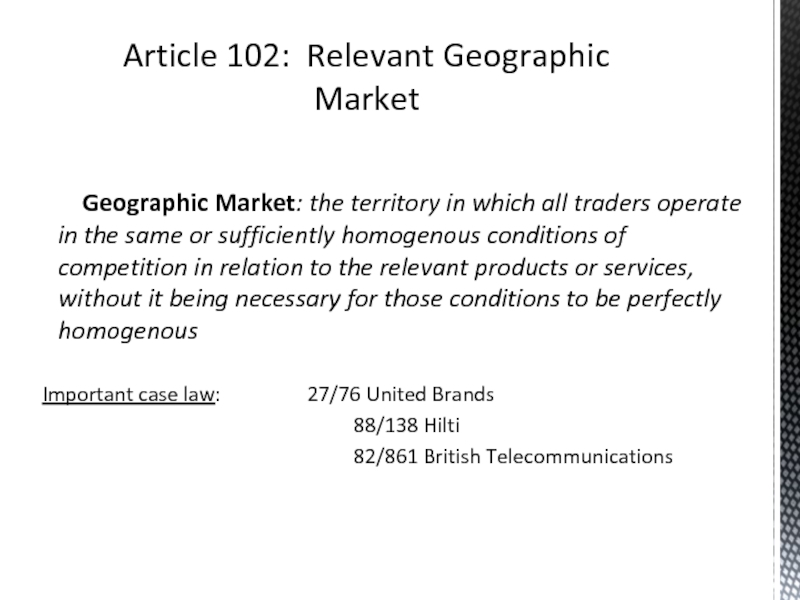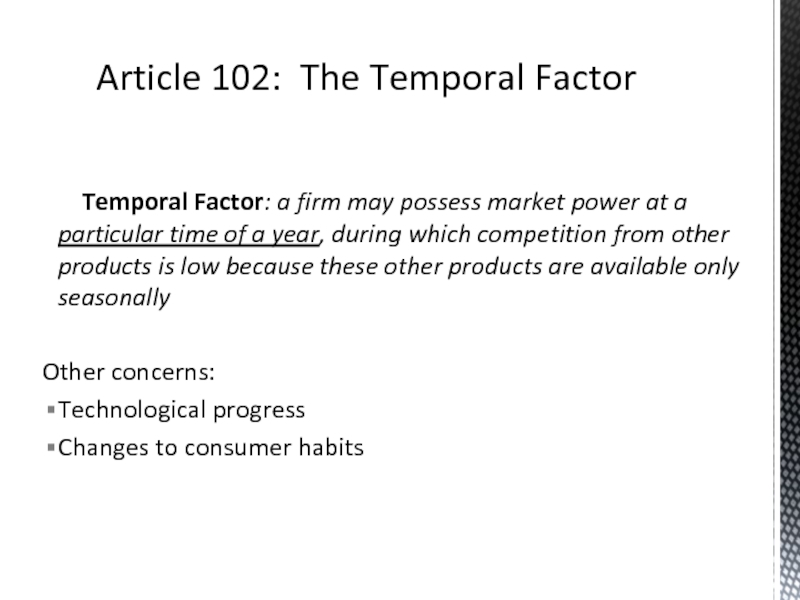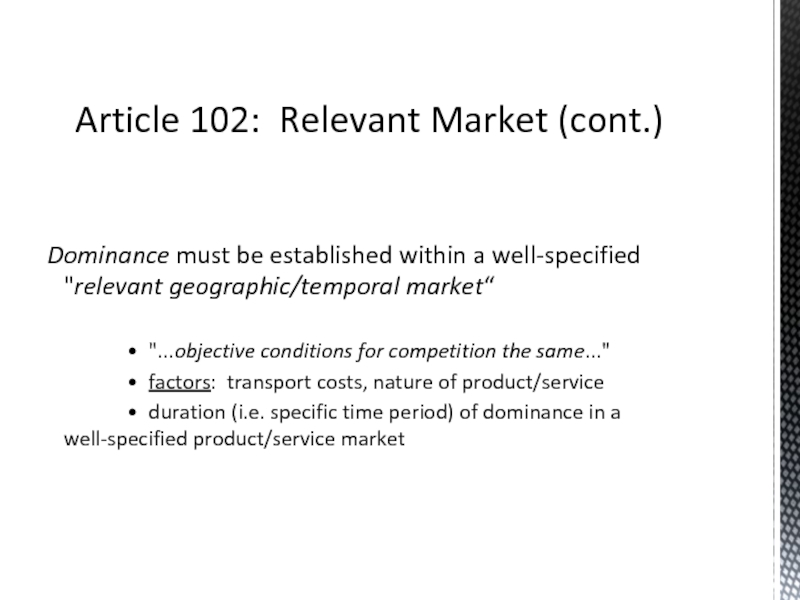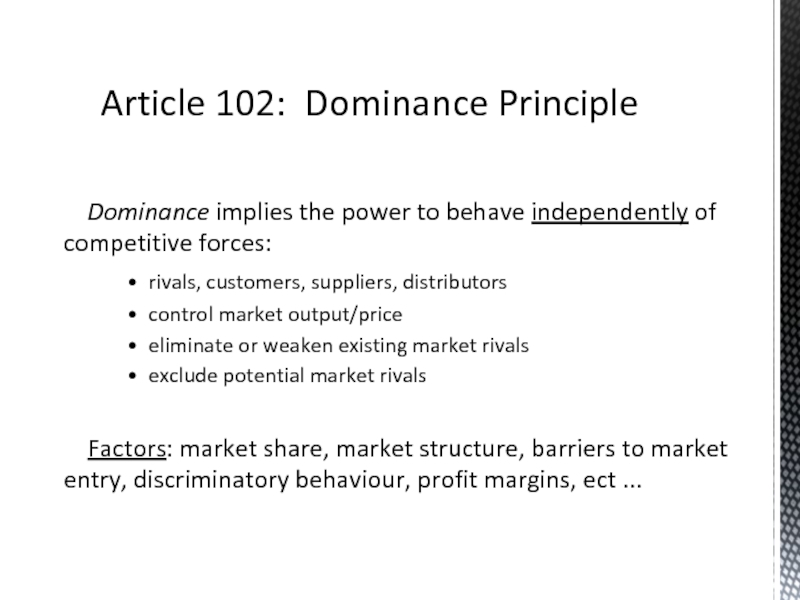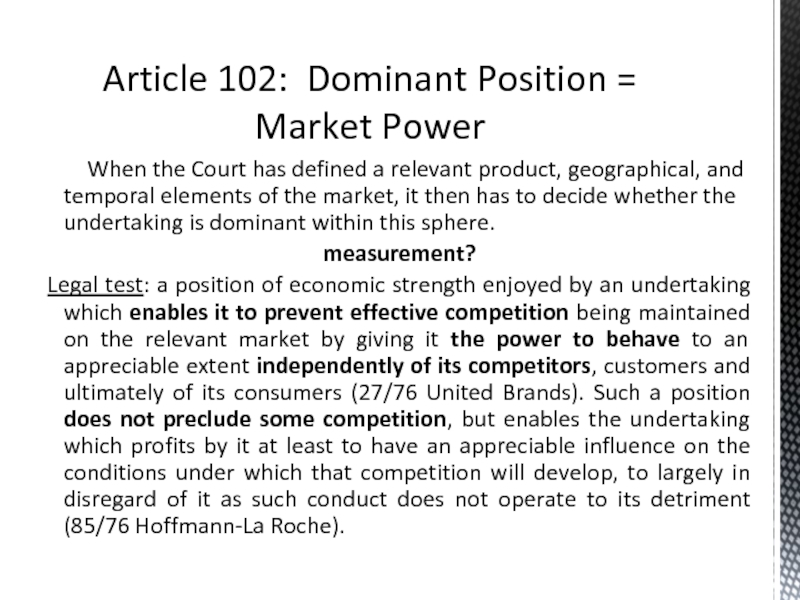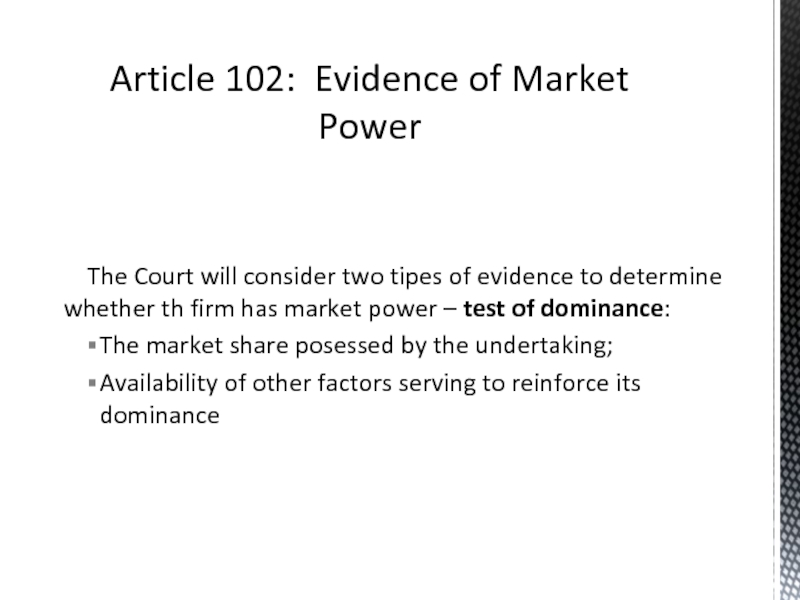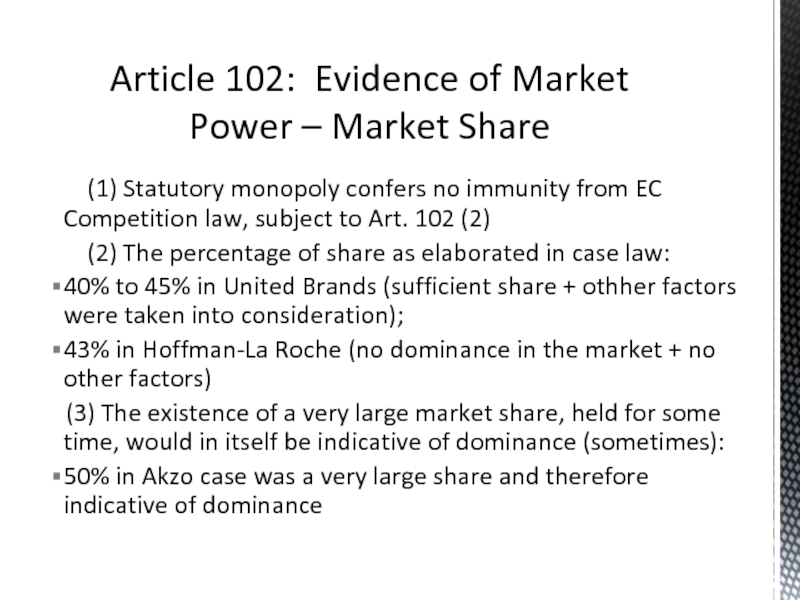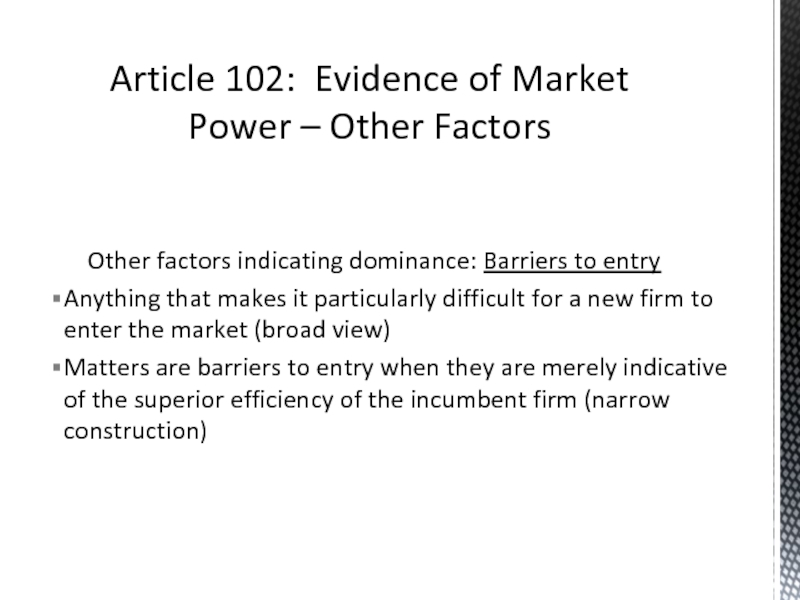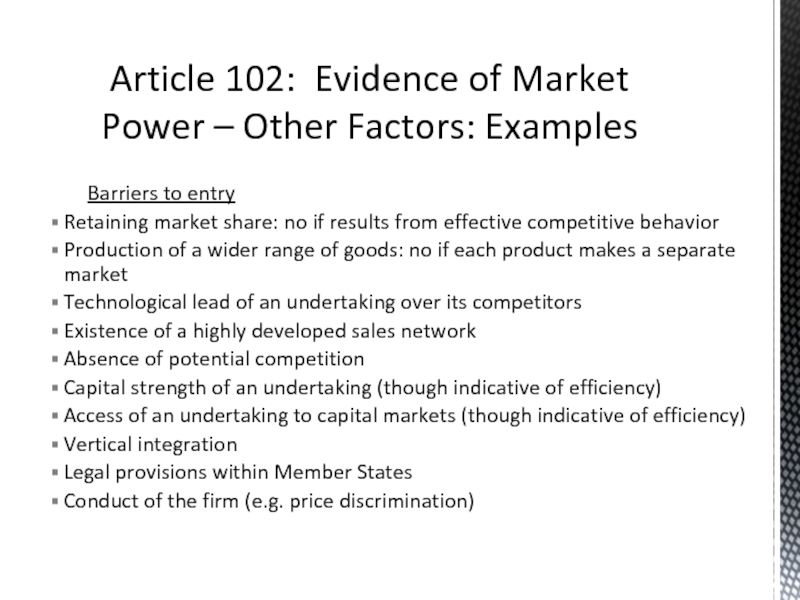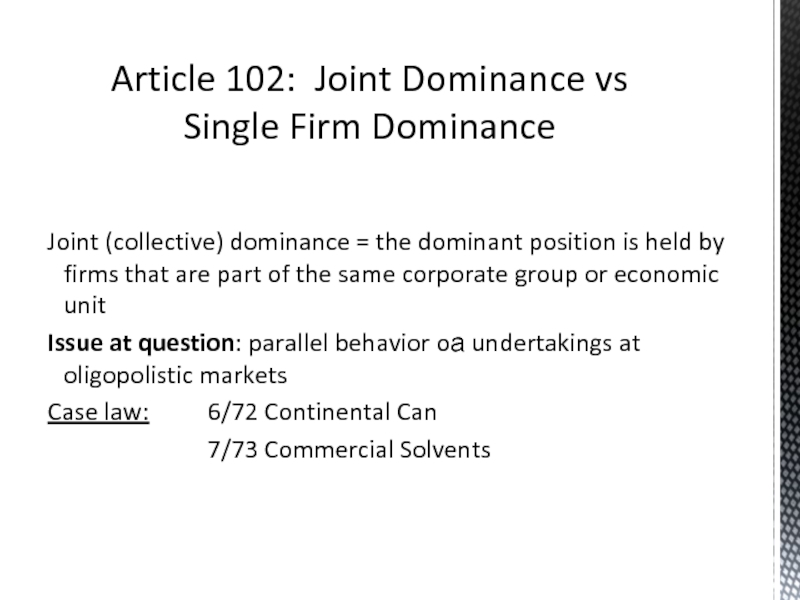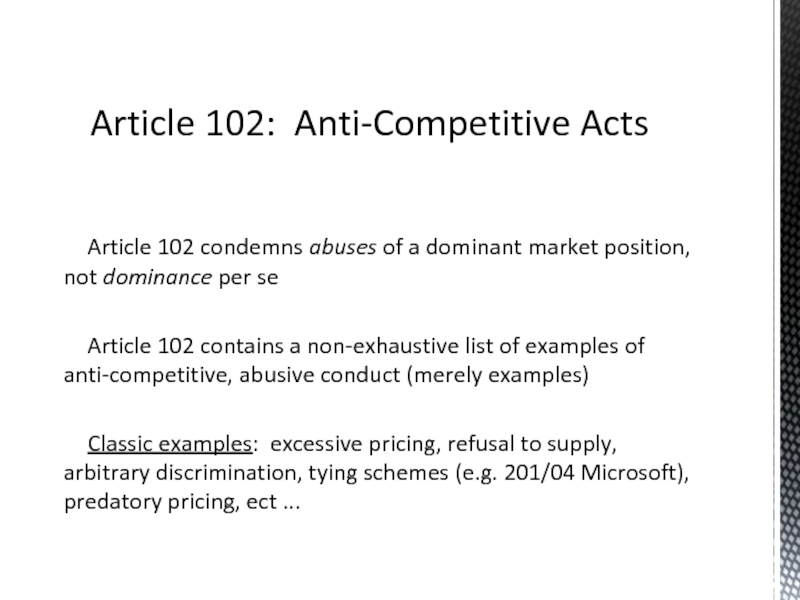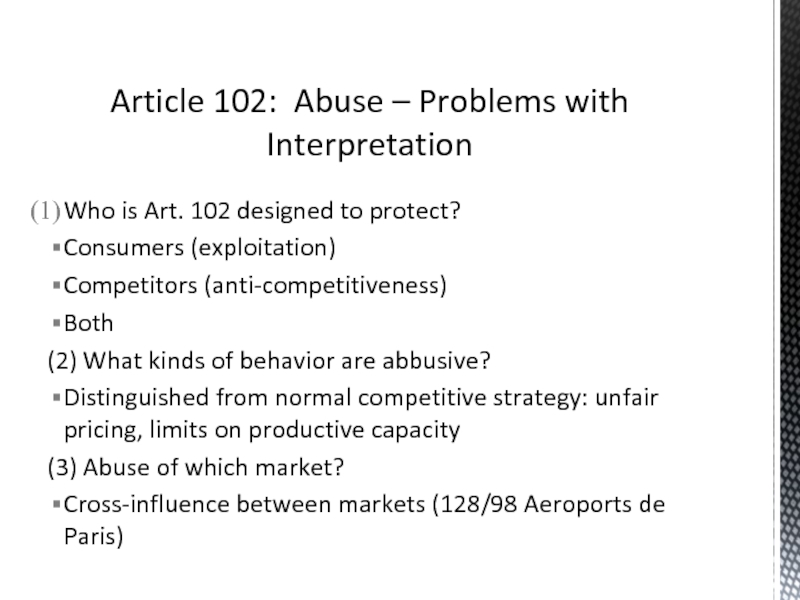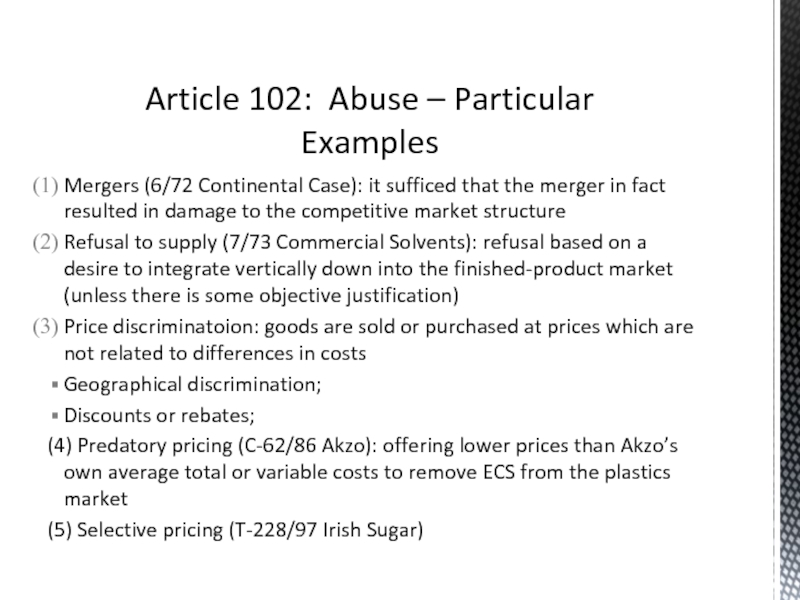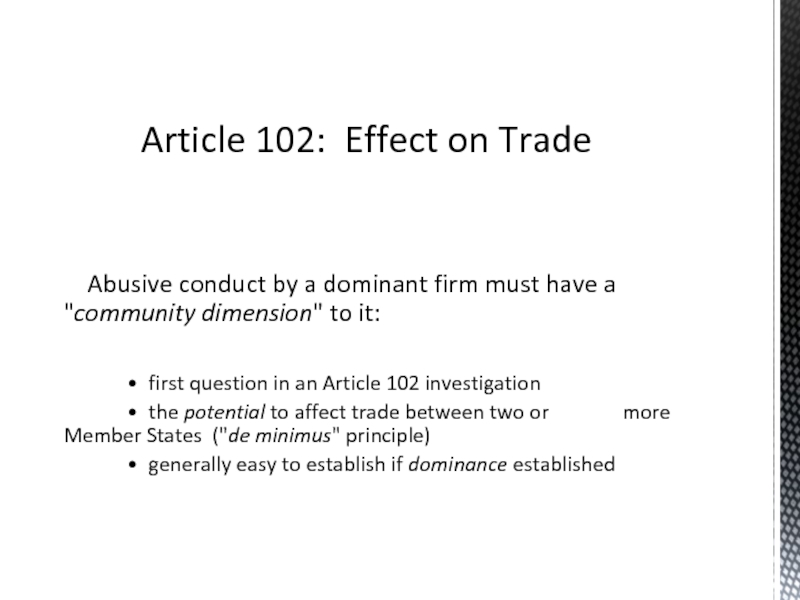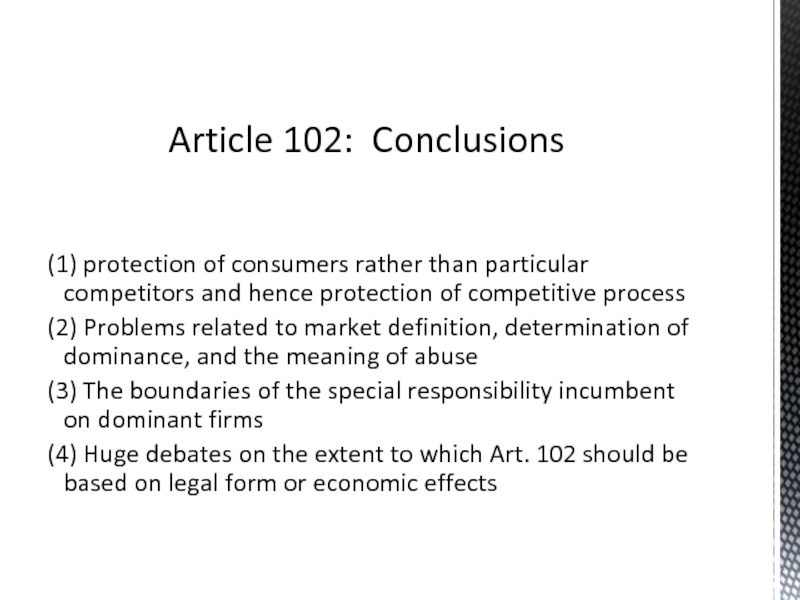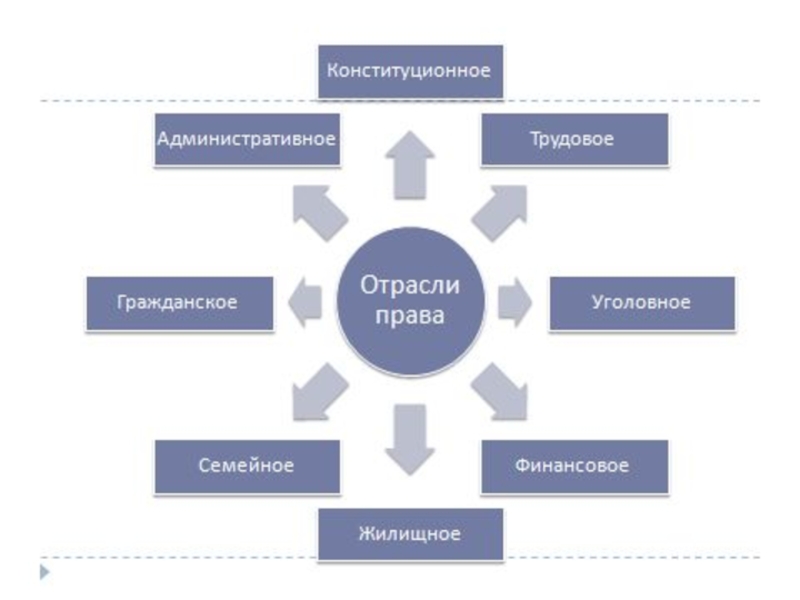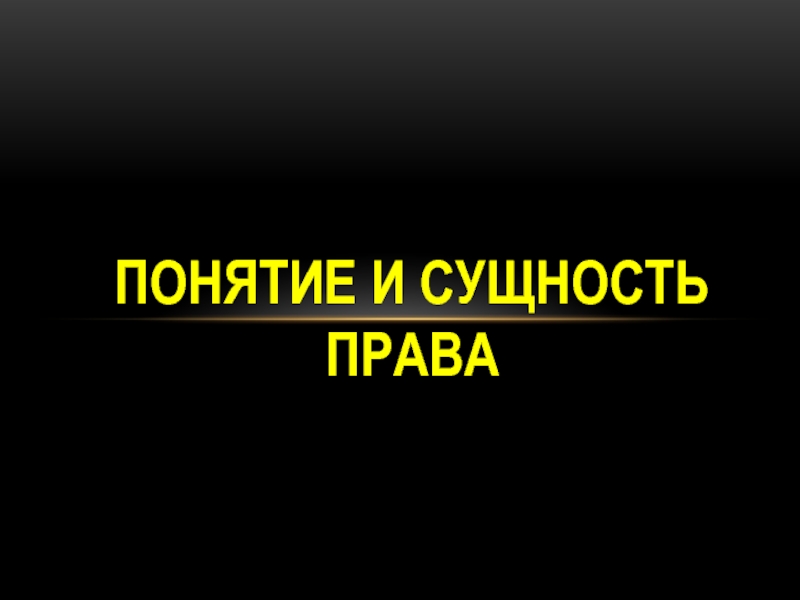- Главная
- Разное
- Дизайн
- Бизнес и предпринимательство
- Аналитика
- Образование
- Развлечения
- Красота и здоровье
- Финансы
- Государство
- Путешествия
- Спорт
- Недвижимость
- Армия
- Графика
- Культурология
- Еда и кулинария
- Лингвистика
- Английский язык
- Астрономия
- Алгебра
- Биология
- География
- Детские презентации
- Информатика
- История
- Литература
- Маркетинг
- Математика
- Медицина
- Менеджмент
- Музыка
- МХК
- Немецкий язык
- ОБЖ
- Обществознание
- Окружающий мир
- Педагогика
- Русский язык
- Технология
- Физика
- Философия
- Химия
- Шаблоны, картинки для презентаций
- Экология
- Экономика
- Юриспруденция
EU Competition Law презентация
Содержание
- 1. EU Competition Law
- 2. EU Commission: http://ec.europa.eu/index_en.htm EU Competition
- 3. Sources of Law TFEU (2009): Articles
- 4. Making markets work better One
- 5. compatible, transparent and fairly standardised Regulatory framework for Competition Law
- 6. Norms of anti-monopoly policy as development of
- 7. Competition was one of the few areas
- 8. EU competition policy is the FUNDAMENTAL ELEMENT
- 9. Liberalization – Arts. 3 and 86 TEC
- 10. Hoekman & Mavroidis (2002) Competition policy: a
- 11. Both policies seek to facilitate economic development
- 12. 1. Integration and efficiency of the EU
- 13. Concepts developed through primary and secondary legislation
- 14. 1. The following shall be prohibited
- 15. Article 101 is the principal vehicle for
- 16. Elements:
- 17. The meaning given to the terms ‘agreement’
- 18. An "undertaking" is any entity engaged in
- 19. Article 101: Field of Application Applies to
- 20. An ADCP must have a "community
- 21. An agreement will not be caught by
- 22. Aggregate market share held by the parties
- 23. If an ADCP has an anti-competitive purpose,
- 24. EU authorities (e.g. Commission, ECJ, EGC) often
- 25. Article 101 (3) provides broad individual exemption
- 26. Article 101 (3) allows the Commission to
- 27. Specialization agreements (Commission Regulation (EU) No 1218/2010
- 28. Research and development (Commission Regulation (EU) No
- 29. Vertical supply and distribution restraints (Commission Regulation
- 30. Technology transfer: a technology transfer agreement
- 31. Especially anti-competitive clauses will not benefit from
- 32. Any abuse by one or more
- 33. Article 102 is used to attack dominant
- 34. Elements: (1) "abusive" conduct (2) "dominant"
- 35. Steps: (1) defining the relevant market
- 36. Dominance must be assessed in relation
- 37. Dominance must be established within a
- 38. Geographic Market: the territory in which
- 39. Temporal Factor: a firm may possess
- 40. Dominance must be established within a well-specified
- 41. The definition of the relevant market
- 42. Dominance implies the power to behave independently
- 43. When the Court has defined a relevant
- 44. The Court will consider two tipes of
- 45. (1) Statutory monopoly confers no immunity from
- 46. Other factors indicating dominance: Barriers to entry
- 47. Barriers to entry Retaining market share: no
- 48. Joint (collective) dominance = the dominant position
- 49. Article 102 condemns abuses of a
- 50. The concept of obuse was ’objective’,
- 51. Who is Art. 102 designed to
- 52. Mergers (6/72 Continental Case): it sufficed
- 53. Objective justification; Proportionality Efficiency Article 102: Defences
- 54. Abusive conduct by a dominant
- 55. (1) protection of consumers rather
Слайд 2EU Commission: http://ec.europa.eu/index_en.htm
EU Competition Authority: http://ec.europa.eu/competition/index_en.html
European Court of Justice:
European General Court: http://curia.europa.eu
Directory of EU Law: http://europa.eu/index_en.htm
Internet Resources
Слайд 3Sources of Law
TFEU (2009): Articles 3(b) , Articles 101-109
• key articles:
Regulations: e.g. Reg. 1/2003 , Reg. 139/2004
• plus hundreds of additional regulations
Case Law: e.g. 48/69 ICI , 27/76 United Brands
• plus thousands of additional cases
Слайд 4Making markets work better
One of the paramount aims of the founding
Mission of the European Commission on competition issues
Слайд 6Norms of anti-monopoly policy as development of provisions of art. 28
Norms of anti-monopoly law for expanding industrial policy of the Community
Control over mergers and acquisitions
Phases of EU Competition Policy development
Слайд 7Competition was one of the few areas of laws for the
EC competition law applies only if EC private parties anti-competitive behavior makes has a sufficient community impact
Competition law and enforcement emerged early as well developed the body of EU administrative law
Development as a top down regulation with the EC institution as the principal actors for carrying out the EC law (from 1958 to nowardays)
2004 big bang in the EU competition policy – bigger role of national competition authorities and courts and the establishment of the EU Competition Network
Evolution of EU Competition Law and Policy
Слайд 8EU competition policy is the FUNDAMENTAL ELEMENT OF THE COMMON MARKET
EU competition policy is within the jurisdiction of Commission and the Competition Directorate General (DG IV)
EU competition policy and EC competition law apply to all undertakings, all entities engaged in commercial activity (corporations, partnerships, individuals, trade associations, state-owned corporations when they operate in a commercial context, and cooperatives)
Introduction
Слайд 9Liberalization – Arts. 3 and 86 TEC rules on the activities
Antitrust – Art. 101 rules on restrictive agreements and concerted practices which cause an appreciable restrictions of competition (price fixing or market sharing) and Art. 102 TEC rules on abuse of a dominant position (Tying or discrimination)
Merger control – rules on control of mergers in Art. 103 TEC
State aid – Art. 107 TEC rules on prevention of undue state intervention
Pillars of the EU Competition Policy
Слайд 10Hoekman & Mavroidis (2002)
Competition policy: a broader set of measures and
Competition law: set of rules and disciplines maintained by the governments aiming to prevent attempts to monopolize the market either through agreements between firms that restrict competition or through unilateral behavior (abuse of a dominant position)
Note: competition policy thus constraints both private and government actions while competition law regulates the behavior of private entities
Competition in the EU: Policy and Law
Слайд 11Both policies seek to facilitate economic development by removing impediments to
Trade Policy & Competition Policy
Слайд 121. Integration and efficiency of the EU market (maximizing consumer welfare
2. Creation of & fair competition at the EU market
3. Protection of consumers and small firms from large aggregations of economic power
Objectives of EU Competition Policy and Law
Слайд 13Concepts developed through primary and secondary legislation and case law:
Undertakings
Concerted practices
Horizontal
Abuse of a dominant position
De minimis doctrine
Mergers
Exemption from application of competition rules
Summary of EU Competition Law Concepts
Слайд 14
1. The following shall be prohibited as incompatible with the common
(a) directly or indirectly fix purchase or selling prices or any other trading conditions;
(b) limit or control production, markets, technical development, or investment;
(c) share markets or sources of supply;
(d) apply dissimilar conditions to equivalent transactions with other trading parties, thereby placing them at a competitive disadvantage;
(e) make the conclusion of contracts subject to acceptance by the other parties of supplementary obligations which, by their nature or according to commercial usage, have no connection with the subject of such contracts.
2. Any agreements or decisions prohibited pursuant to this article shall be automatically void.
3. The provisions of paragraph 1 may, however, be declared inapplicable in the case of:
- any agreement or category of agreements between undertakings,
- any decision or category of decisions by associations of undertakings,
- any concerted practice or category of concerted practices,
which contributes to improving the production or distribution of goods or to promoting technical or economic progress, while allowing consumers a fair share of the resulting benefit, and which does not:
(a) impose on the undertakings concerned restrictions which are not indispensable to the attainment of these objectives;
(b) afford such undertakings the possibility of eliminating competition in respect of a substantial part of the products in question.
Article 101
Слайд 15 Article 101 is the principal vehicle for the control of anti-competitive
Objectives:
(1) protect consumers
(2) protect (small) firms (e.g. cartel rivals)
(3) protect the "single market" (an EU project)
(4) enhance market efficiency
Article 101: Introduction
Слайд 16Elements:
(1) agreement, decision or
(2) may affect trade between Member States
(3) object or effect of preventing, restricting or distorting competition within the internal market
Broad base of liability under Article 101(1)
... but ...
Broad exemptions under Article 101(3)
Article 101: General Scheme
Слайд 17The meaning given to the terms ‘agreement’ and etc.
The relationship between
The extent to which economic analyses does and should take place within Art. 101 (1)
The interpretation accorded to Art. 101 (3), including whether non-economic factors can be taken into account
Article 101: key features
Слайд 18 An "undertaking" is any entity engaged in a commercial or economic
The EU Commission has expansive interpretations of "agreements“, "decisions" , and "concerted practices"
Important case law: 41/69 Chemiefarma
48/69 ICI
119/92 Huls
Article 101: Key Terminology
Слайд 19Article 101: Field of Application
Applies to both "horizontal“ (being made between
Undertakings must be independent :
• no parent-subsidiary relationship
• no principal-agent relationship
Non-EU undertakings can be liable under Article 101(1)
Public authorities can be liable under Article 101(1)
• e.g. require licensees to charge minimum prices
Слайд 20
An ADCP must have a "community dimension" to it:
• first question
• the potential to affect trade between two or more Member States ("de minimus" principle)ice on Agreements of Minor Importance
Article 101: Effect on Trade
Слайд 21An agreement will not be caught by article 101 (1) if
competition or
inter-state trade or
where the preceding thresholds are not exceeded by more than 2% in two successive years
Article 101 (1): the de minimis doctrine
Слайд 22Aggregate market share held by the parties does not exceed 10%
15% for cases where the parties are not competitors on the relevant markets
10% threshold for cases where it is difficult to classify the agreement
5% for vertical cases in which competition may be restricted by the cumulative effect of the agreements (for both competitors and non-competitors)
30% of relevant market if parallel networks of agreements having similar effect
Criterion of application of de minimis doctrine
Слайд 23 If an ADCP has an anti-competitive purpose, an anti-competitive effect is
Article 101(1) contains a non-exhaustive list of examples of anti-competitive ADCP: price-fixing, minimum-price, market sharing, output limits, research/investment limits, arbitrary discrimination, fidelity/loyalty rebates, tying clauses, refusal to supply, minimum purchases, ect ...
Article 101: Anti-Competitive Acts
Слайд 24 EU authorities (e.g. Commission, ECJ, EGC) often engage in a "rule
• use economic analysis to carefully weigh/balance the pro- and anti-competitive effects of ADCP
• ADCP legal if pro-competitive effects dominate
• ADCP illegal if anti-competitive effects dominate
• certain ADCP condemned without analysis (per se rule)
Article 101: Rule of Reason
Слайд 25 Article 101 (3) provides broad individual exemption to Article 101(1) if
(1) improves a production/distribution process or promotes technical/economic progress
(2) allows consumers a fair share of the resulting benefit
(3) imposes necessary restrictions
(4) imposes no threat to competition in the market
Certain EU regulations ("block exemptions") provide narrow exemptions to Article 101(1) for broad classes of ADCP.
Article 101: Exemptions
Слайд 26Article 101 (3) allows the Commission to declare the provisions of
Object: excluding a generic type of agreement from the ambit of Art 101 (1)
Such agreements are said to improve economic efficiency by facilitating co-ordination and reducing distribution costs
Common features in Regulations on BE:
State the reasons for their enactment;
Set out the substance of the exemption;
Contain provisions limiting the size of the firms that can take advantage of them;
List the types of clauses that are not allowed within the relevant agreement
Article 101: Block Exemptions
Слайд 27Specialization agreements (Commission Regulation (EU) No 1218/2010 of 14 December 2010):
unilateral
reciprocal specialisation agreement: an agreement between two or more parties which are active on the same product market, by virtue of which two or more parties on a reciprocal basis agree to fully or partly cease or refrain from producing certain but different products and to purchase these products from the other parties, who agree to produce and supply them;
joint production agreement: an agreement by virtue of which two or more parties agree to produce certain products jointly
Article 101: Area of application of block exemptions
Слайд 28Research and development (Commission Regulation (EU) No 1217/2010 of 14 December
joint research and development of contract products or contract technologies and joint exploitation of the results of that research and development;
joint exploitation of the results of research and development of contract products or contract technologies jointly carried out pursuant to a prior agreement between the same parties;
joint research and development of contract products or contract technologies excluding joint exploitation of the results;
paid-for research and development of contract products or contract technologies and joint exploitation of the results of that research and development;
joint exploitation of the results of paid-for research and development of contract products or contract technologies pursuant to a prior agreement between the same parties;
paid-for research and development of contract products or contract technologies excluding joint exploitation of the results.
Article 101: Area of application of block exemptions
Слайд 29Vertical supply and distribution restraints (Commission Regulation (EU) No 330/2010 of
Excluded restrictions:
The Regulation applies to all vertical restraints other than the abovementioned hardcore restraints. However, it does impose specific conditions on three vertical restraints:
non-compete obligations during the contract;
non-compete obligations after termination of the contract;
the exclusion of specific brands in a selective distribution system.
When the conditions are not fulfilled, these vertical restraints are excluded from the exemption by the BER. However, the BER continues to apply to the remaining part of the vertical agreement if that part is severable (i.e. can operate independently) from the non-exempted vertical restraints.
Article 101: Area of application of block exemptions
Слайд 30
Technology transfer: a technology transfer agreement is a licensing agreement where
2 instruments:
the technology transfer block exemption regulation ("TTBER"): exempts certain categories of licensing agreements concluded between companies that have limited market power and that respect certain conditions set out in the TTBER. Such agreements are deemed to have no anticompetitive effects or, if they do, the positive effects outweigh the negative ones.
accompanying Guidelines: provide guidance on the application of the TTBER as well as on the application of EU competition law to technology transfer agreements that fall outside the safe harbour of the TTBER.
These instruments will expire on 30 April 2014. The Commission has now drafted a proposal for a revised TTBER and Guidelines. The current consultation is seeking stakeholders' views on this proposal.
Article 101: Area of Application of Block Exemptions
Слайд 31Especially anti-competitive clauses will not benefit from the block exemption
Vertical price
Exclusion of resale price maintenance
Fixed or minimum sale price as a result of pressure from or incentives offered by any of the parties
(2) Territorial protection:
Permissible to restrict sales to end users by a buyer operating at the wholesale level of trade;
Restriction does not limit sales by the customers to the buyer;
Permissible to restrict sales to unauthorised distributors by the members of a selective distribution system;
Possible to restrict the buyer of components for use from selling them to a customer who would use them to make goods that would compete with those of a supplier.
Article 101: The Black List
Слайд 32
Any abuse by one or more undertakings of a dominant position
Such abuse may, in particular, consist in:
(a) directly or indirectly imposing unfair purchase or selling prices or other unfair trading conditions;
(b) limiting production, markets or technical development to the prejudice of consumers;
(c) applying dissimilar conditions to equivalent transactions with other trading parties, thereby placing them at a competitive disadvantage;
(d) making the conclusion of contracts subject to acceptance by the other parties of supplementary obligations which, by their nature or according to commercial usage, have no connection with the subject of such contracts.
Article 102
Слайд 33 Article 102 is used to attack dominant firms (e.g. monopolies, market
The essence is the control the market power by one or a number of firms.
Objectives:
(1) protect consumers
(2) protect smaller firms (e.g. rivals, suppliers)
(3) protect the "single market"
(4) enhance market efficiency
Article 102: Introduction
Слайд 34
Elements:
(1) "abusive" conduct
(2) "dominant" firm
(3) may affect trade between Member States
Narrow
No exemptions under Article 102
Article 102: General Scheme
Слайд 35
Steps:
(1) defining the relevant market as precondition to defining the dominance
(2)
(3) determining whether it has abused it dominant position
(4) determining whether there are any available defences
Article 102: Steps
Слайд 36
Dominance must be assessed in relation to three variables:
The product market;
The
The temporal factor
Article 102: Relevant Market
Слайд 37
Dominance must be established within a well-specified "relevant product/service market“
• area
• EU Commission tries to define markets narrowly
• factor: cross-elasticity of demand/supply
• Notice on the Definition of the Relevant Market
Important case law: 27/76 United Brands
322/81 Michelin
22/78 Hugin
Article 102: Relevant Product Market
Слайд 38
Geographic Market: the territory in which all traders operate in the
Important case law: 27/76 United Brands
88/138 Hilti
82/861 British Telecommunications
Article 102: Relevant Geographic Market
Слайд 39
Temporal Factor: a firm may possess market power at a particular
Other concerns:
Technological progress
Changes to consumer habits
Article 102: The Temporal Factor
Слайд 40Dominance must be established within a well-specified "relevant geographic/temporal market“
• "...objective
• factors: transport costs, nature of product/service
• duration (i.e. specific time period) of dominance in a well-specified product/service market
Article 102: Relevant Market (cont.)
Слайд 41
The definition of the relevant market will be viewed differently depending
The Commission will inquire into demand substitutability, supply substitutability and potential competition - SSNIP test
The Commission will consider: evidence of substitution in the recent past or where there have been shocks in the market;n the views of consumers and competitors; quantitative econometric tests; evidence of consumer preferences where available; barriers and costs entailed in substitution; and whether there are distinkt groups of customers for the product.
Article 102: Relevant Market – Commission’s Approach
Слайд 42 Dominance implies the power to behave independently of competitive forces:
• rivals,
• control market output/price
• eliminate or weaken existing market rivals
• exclude potential market rivals
Factors: market share, market structure, barriers to market entry, discriminatory behaviour, profit margins, ect ...
Article 102: Dominance Principle
Слайд 43 When the Court has defined a relevant product, geographical, and temporal
measurement?
Legal test: a position of economic strength enjoyed by an undertaking which enables it to prevent effective competition being maintained on the relevant market by giving it the power to behave to an appreciable extent independently of its competitors, customers and ultimately of its consumers (27/76 United Brands). Such a position does not preclude some competition, but enables the undertaking which profits by it at least to have an appreciable influence on the conditions under which that competition will develop, to largely in disregard of it as such conduct does not operate to its detriment (85/76 Hoffmann-La Roche).
Article 102: Dominant Position = Market Power
Слайд 44 The Court will consider two tipes of evidence to determine whether
The market share posessed by the undertaking;
Availability of other factors serving to reinforce its dominance
Article 102: Evidence of Market Power
Слайд 45 (1) Statutory monopoly confers no immunity from EC Competition law, subject
(2) The percentage of share as elaborated in case law:
40% to 45% in United Brands (sufficient share + othher factors were taken into consideration);
43% in Hoffman-La Roche (no dominance in the market + no other factors)
(3) The existence of a very large market share, held for some time, would in itself be indicative of dominance (sometimes):
50% in Akzo case was a very large share and therefore indicative of dominance
Article 102: Evidence of Market Power – Market Share
Слайд 46 Other factors indicating dominance: Barriers to entry
Anything that makes it particularly
Matters are barriers to entry when they are merely indicative of the superior efficiency of the incumbent firm (narrow construction)
Article 102: Evidence of Market Power – Other Factors
Слайд 47 Barriers to entry
Retaining market share: no if results from effective competitive
Production of a wider range of goods: no if each product makes a separate market
Technological lead of an undertaking over its competitors
Existence of a highly developed sales network
Absence of potential competition
Capital strength of an undertaking (though indicative of efficiency)
Access of an undertaking to capital markets (though indicative of efficiency)
Vertical integration
Legal provisions within Member States
Conduct of the firm (e.g. price discrimination)
Article 102: Evidence of Market Power – Other Factors: Examples
Слайд 48Joint (collective) dominance = the dominant position is held by firms
Issue at question: parallel behavior oа undertakings at oligopolistic markets
Case law: 6/72 Continental Can
7/73 Commercial Solvents
Article 102: Joint Dominance vs Single Firm Dominance
Слайд 49
Article 102 condemns abuses of a dominant market position, not dominance
Article 102 contains a non-exhaustive list of examples of anti-competitive, abusive conduct (merely examples)
Classic examples: excessive pricing, refusal to supply, arbitrary discrimination, tying schemes (e.g. 201/04 Microsoft), predatory pricing, ect ...
Article 102: Anti-Competitive Acts
Слайд 50
The concept of obuse was ’objective’, and could apply to any
No need to prove that the abuse had been brought about by the firm’s market power.
Article 102: Abuse
Слайд 51
Who is Art. 102 designed to protect?
Consumers (exploitation)
Competitors (anti-competitiveness)
Both
(2) What kinds
Distinguished from normal competitive strategy: unfair pricing, limits on productive capacity
(3) Abuse of which market?
Cross-influence between markets (128/98 Aeroports de Paris)
Article 102: Abuse – Problems with Interpretation
Слайд 52
Mergers (6/72 Continental Case): it sufficed that the merger in fact
Refusal to supply (7/73 Commercial Solvents): refusal based on a desire to integrate vertically down into the finished-product market (unless there is some objective justification)
Price discriminatoion: goods are sold or purchased at prices which are not related to differences in costs
Geographical discrimination;
Discounts or rebates;
(4) Predatory pricing (C-62/86 Akzo): offering lower prices than Akzo’s own average total or variable costs to remove ECS from the plastics market
(5) Selective pricing (T-228/97 Irish Sugar)
Article 102: Abuse – Particular Examples
Слайд 54
Abusive conduct by a dominant firm must have a "community dimension"
• first question in an Article 102 investigation
• the potential to affect trade between two or more Member States ("de minimus" principle)
• generally easy to establish if dominance established
Article 102: Effect on Trade
Слайд 55
(1) protection of consumers rather than particular competitors and hence protection
(2) Problems related to market definition, determination of dominance, and the meaning of abuse
(3) The boundaries of the special responsibility incumbent on dominant firms
(4) Huge debates on the extent to which Art. 102 should be based on legal form or economic effects
Article 102: Conclusions
